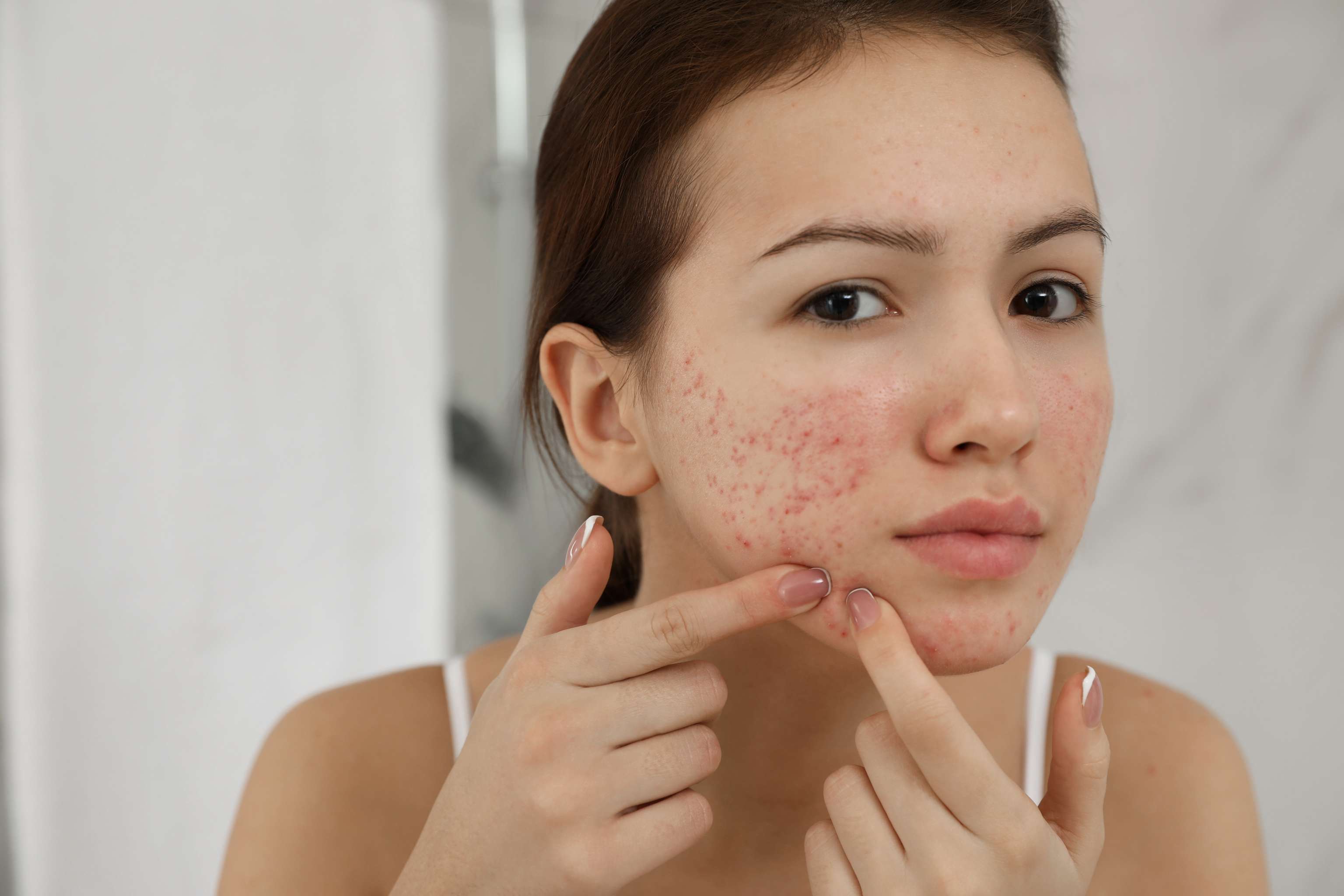Acne in our latitudes

What is acne?
Not all blemished skin is immediately associated with acne. The skin disease itself can not be defined exactly, because acne occurs in different ways. Most often, the disease appears on the face in connection with pimples and blackheads. More rarely, it is also seen to occur in the décolleté and back areas.
Acne vulgaris:
The most common form of expression is acne vulgaris, or common acne. Hormonal changes in the body due to puberty in adolescents can cause three different levels of severity to develop. Androgens, the male sex hormones, are produced more in males and in lesser amounts in females during puberty. This hormone stimulates sebum production on the skin. However, hormonal changes during puberty also cause horny material on the skin to become more prominent, closing off the outlets of the sebaceous glands. White blackheads develop as a result of sebum accumulation under the skin.
Usually, the first two degrees of common acne do not present any difficulties in therapeutic treatment in adulthood. In the third subtype, also called acne conglobata, scars may appear as it heals.
Many of the other forms of acne, such as medication acne or acne inversa, have other causes such as antibiotics, stress, or diet. The time of year, especially winter, can also present difficulties for preventing acne.
Acne in winter:
As temperatures drop during the winter months, the risk of developing a dermatological condition like acne also increases. The air outside the four walls is cold and dry, which means our largest organ, the skin, can absorb less moisture in the air. The epidermis, the outermost layer of skin, decreases the presence of our thin protective acid layer. As a result, antibacterial activity is minimized and harmful environmental factors such as UV radiation can dry out and injure the skin's surface.
According to Prof. Dr. Okamoto, dermatologist in Vienna, the cold and dry air from the window openings in the apartment is heated. However, this room air does not have enough moisture and is additionally dried out even more by heating it inside. The result is a drying out of the mouth and nose, as well as itchy and dry skin. These factors of the winter months offers a favorable attack surface for harmful external influences, which can have acne as a consequence.
Acne and diet:
Diet can also be an important aspect of an acne condition. A systematic review of fourteen different studies found a link between acne and dairy consumption. The meta-analysis, published in 2018 in the journal Nutrition, evaluated a total of 78,529 participants from the different studies. It found that intake of milk and dairy products was associated with a higher likelihood of acne for people aged 7 to 30, regardless of the amount or frequency.
However, due to bias in the design and process of the studies (two studies had only women, three had only men, different questionnaires to complete, etc.), this meta-analysis should be interpreted with caution.
In general, dietary factors are thought to be an important factor in acne vulgaris, as consumption of dairy as well as carbohydrates can activate a specific protein (mTORC1) that is responsible for sebum production, among other things.
In a nutshell:
Due to the variation in risk factors that can lead to different forms of acne, the disease is the most common dermatological diagnosis in our latitudes with 22-32%. While milder manifestations of the dermatological disease could also be treated by regular washing and grooming of the body, a dermatologist should definitely be visited to make a concrete diagnosis.
Sources
- Schaefer I, Rustenbach SJ, Zimmer L, Augustin M. (2008): Prevalence of skin diseases in a cohort of 48,665 employees in Germany. Dermatology; 217(2):169-72. doi: 10.1159/000136656. Epub 2008 Jun 5. PMID: 18525204.
- Juhl, C.R.; Bergholdt, H.K.M.; Miller, I.M.; Jemec, G.B.E.; Kanters, J.K.; Ellervik, C. (2018):Dairy Intake and Acne Vulgaris: A Systematic Review and Meta-Analysis of 78,529 Children, Adolescents, and Young Adults. Nutrients
- Melnik B., Chen W. (2018) Akne und Rosazea. In: Plewig G., Ruzicka T., Kaufmann R., Hertl M. (eds) Braun-Falco’s Dermatologie, Venerologie und Allergologie. Springer Reference Medizin. Springer, Berlin, Heidelberg.
- Westliche Fehlernährung führt zur Akne (Prof. Dr. med. Bodo C. Melnik)
- Akne (Netdoktor)
- Trockene Haut im Winter (Hautarzt Univ.Prof.Dr. Ichiro Okamoto)
- Akne ist nicht gleich Akne vulgaris (Ärzteblatt)

Danilo Glisic
Last updated on 16.12.2020
Your personal medication assistant
Browse our extensive database of medications from A-Z, including effects, side effects, and dosage.
All active ingredients with their effects, applications, and side effects, as well as the medications they are contained in.
Symptoms, causes, and treatments for common diseases and injuries.
The presented content does not replace the original package insert of the medication, especially regarding the dosage and effects of individual products. We cannot assume liability for the accuracy of the data, as the data has been partially converted automatically. Always consult a doctor for diagnoses and other health-related questions.
© medikamio